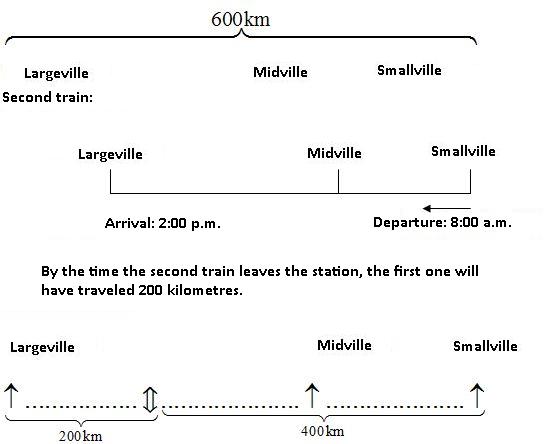SOLVING EXCERCISES (Continued)
E) 30 years ago, the water plumbing of Chickenville (don't look for it, it doesn't exist) was renovated. Each inhabitant had 90 litres of water per day. Since then, Chickenville has developed in every sense. It is not the place it used to be; there are (more) mobile phones, more television sets, more cars, more noise, but the same amount of water goes into town.
In the census carried out this year, city hall reports that Chickenville now has 500 more inhabitants than it did 30 years ago.
This population increase has created many water-related problems. Nowadays, the people of Chickenville have 10 litres of water less per day/ per inhabitant. Those "90 litres per inhabitant / per day" are now only a sweet, distant memory.
What is the current population of chickenville today?
Answer: 4.500 inhabitants
Solution:
Try to do this exercise on your own. However, here is the solution to clarify any doubts.
According to the information, we find out that each inhabitant is now using 90 – 10 = 80 litres of water per day. Thus, the new 500 inhabitants are using daily: 500 x 80 = 40.000 litres
These 40.000 litres have been removed from the previous inhabitants' daily use.
SInce each inhabitant now has 10 litres less, the number of previous inhabitants will be:

The current number of inhabitants is: 4000 + 500 = 4500
Lets prove it:
The water consumed 30 years ago and the amount consumed today is the same. However, each inhabitant now has less water available per day because there is more people living in Chickenville.
30 years ago, Chickenville had a population of 4000 people. Each inhabitant had 90 litres of water per day available. Total:
4000 x 90 = 360 000 litres
Currently, Chickenville has a population of 4500 people. Each inhabitant has 80 litres of water per day available. Total:
4500 x 80 = 360 000 litres
As you can see, the total amount of water is the same.
F) Consecutive numbers are those numbers that come one after the other in a specific order: for example, 3,4,5,6,..
There are three consecutive numbers which when added give a total of 75. Which are the numbers?
Answer: 24, 25 and 26
Lets solve this exercise:
Solution:
It so happens that in consecutive numbers, the second number is higher than the first number one whole unit. The third number is 2 units larger than the first one.
For example: If the numbers are: 1,2,3
The second number, 2, is one unit larger than the 1st number,1.
The third number, 3, is two units larger than the first number, 1.
If these numbers were the same, we would simply have to divide their total sum by 3.
This way we can calculate the values for the first, second, and third number.
For the consecutive numbers in this exercise to be equal, we see we have a residue of 3 units (the 2nd number is one unit larger than the 1st number and the 3rd number is two units larger than the first number).
If the total sum of the example (1,2,3) is: 1 + 2 + 3 = 6, we subtract the three units we have as residue for them to be equal to the first number, we have: 6 – 3 = 3
This result, 3, is the sum of three equal numbers (to the first number). As a result, each one would equal:

We have calculated the first number. Since they are consecutive, the second number will be 2, and the third number, 3.
Lets apply this to the exercise:
The sum of these consecutive numbers is 75. The sum of these three numbers, if they were equal to the first number, would be: 75 – 3 = 72

Since they are consecutive, each number would be: 24, 25, and 26
G) A train leaves Largeville at 6 o'clock in the morning. It arrives at Smallville at 12 o'clock (at noon). The average speed for trains operating in this sector equal to 100 km/h.
Between Largeville and Smallville, as you can imagine, is the village of Midville.
At 8 o'clock in the morning, another train leaves from Smallville (average speed:100 km/h) to Largeville and they curiously arrive at Midville at the same time. How many kilometres are there between Largeville and Midville?
Answer: 400 kilometres
Solution:
With a simple line, we will represent the information given in the exercise:

Since it has taken 6 hours for this train to reach Smallville at an average speed of 100 km/h, the distance between Largeville and Smallville is: 100 x 6 = 600 km.

At 8 o'clock in the morning, both trains are at the same distance from Midville. This means that Smallville is 200 km away from Midville.
The distance between Largeville and Midville is: 200 + 200 = 400 km.
H) 232 candy bars are given away to 31 children; 15 candy bars were left. How many candy bars did each child get?
Answer: 7 candy bars
Solution:
You already know that if you take the remainder of a division and you subtract it from its dividend, the division would be exact (no remainder):

We subtract the remainder (1) from the dividend (231), we would have 230. Now, our division is exact:

In both cases, the quotient is the same.
In the candy bar exercise, we see that if we subtract the 15 candy bars, which were not given away, to the total amount of candy bars, 232, the quotient equals the amount of candy bars given to each child.
